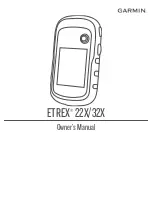
You can add a .gpx file that contains waypoints by transferring
the file to the GPX folder (
Transferring Files to Your Device
).
Creating a Waypoint
You can save your current location as a waypoint.
1
Select
Mark Waypoint
.
2
If necessary, select a field to make changes to the waypoint.
3
Select
Done
.
Projecting a Waypoint
You can create a new location by projecting the distance and
bearing from a marked location to a new location.
1
Select
Waypoint Manager
.
2
Select a waypoint.
3
Select
menu
>
Project Waypoint
.
4
Enter the bearing, and select
Done
.
5
Select a unit of measure.
6
Enter the distance, and select
Done
.
7
Select
Save
.
Navigating to a Waypoint
1
Select
Where To?
>
Waypoints
.
2
Select a waypoint.
3
Select
Go
.
Finding a Location by Name
1
Select
Where To?
>
Waypoints
>
menu
>
Spell Search
.
2
Enter the name or part of the name.
3
Select
Go
.
Editing a Waypoint
1
Select
Waypoint Manager
.
2
Select a waypoint.
3
Select an item to edit, such as the name.
4
Enter the new information, and select
Go
.
Deleting a Waypoint
1
Select
Waypoint Manager
.
2
Select a waypoint.
3
Select
menu
>
Delete
.
Waypoint Averaging
You can refine a waypoint location for more accuracy. When
averaging, the device takes several readings at the same
location and uses the average value to provide more accuracy.
1
Select
Waypoint Manager
.
2
Select a waypoint.
3
Select
menu
>
Average Location
.
4
Move to the waypoint location.
5
Select
Start
.
6
Follow the on-screen instructions.
7
When the confidence status bar reaches 100%, select
Save
.
For best results, collect four to eight samples for the waypoint,
waiting at least 90 minutes between samples.
Routes
A route is a sequence of waypoints or locations that leads you to
your final destination.
Creating a Route
1
Select
Route Planner
>
Create Route
>
Select First Point
.
2
Select a category.
3
Select the first point in the route.
4
Select
Use
.
5
Select
Select Next Point
to add additional points to the
route.
6
Select
back
to save the route.
Viewing a Route on the Map
1
Select
Route Planner
.
2
Select a route.
3
Select
View Map
.
Navigating a Saved Route
1
Select
Where To?
>
Routes
.
2
Select a route.
3
Select
Go
.
Viewing the Active Route
1
While navigating a route, select
Active Route
.
2
Select a point in the route to view additional details.
Editing the Name of a Route
1
Select
Route Planner
.
2
Select a route.
3
Select
Change Name
.
4
Enter the new name.
Editing a Route
1
Select
Route Planner
.
2
Select a route.
3
Select
Edit Route
.
4
Select a point.
5
Select an option:
• To view the point on the map, select
Review
.
• To change the order of the points on the route, select
Move Up
or
Move Down
.
• To insert an additional point on the route, select
Insert
.
The additional point is inserted before the point you are
editing.
• To remove the point from the route, select
Remove
.
6
Select
back
to save the route.
Deleting a Route
1
Select
Route Planner
.
2
Select a route.
3
Select
Delete Route
.
Reversing a Route
You can switch the start and end points of your route to navigate
the route in reverse.
1
Select
Route Planner
.
2
Select a route.
3
Select
Reverse Route
.
Stopping Navigation
Select
Where To?
>
Stop Navigation
.
Tracks
A track is a recording of your path. The track log contains
information about points along the recorded path, including time,
location, and elevation for each point. By default, the device
creates a track log while you move with the device turned on.
Recording Track Logs
1
From the Main Menu, select
Setup
>
Tracks
>
Track Log
.
2
Waypoints, Routes, and Tracks


















